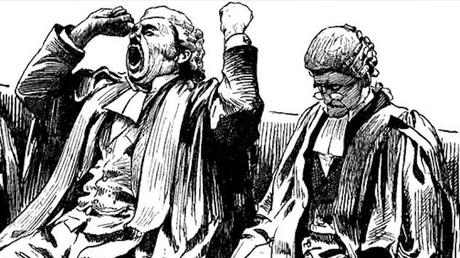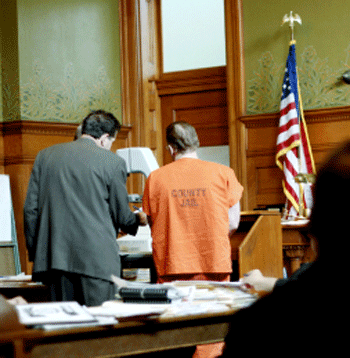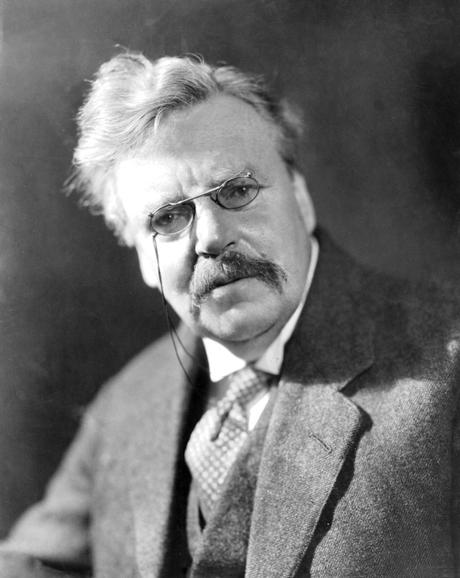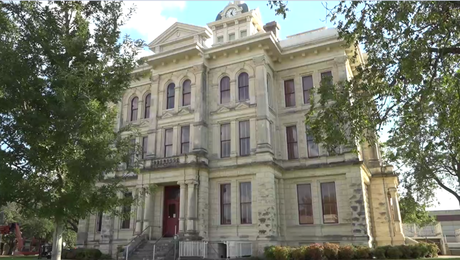 Attorneys who merely go through the motions are rarely chastised. In fact, their lack of diligence is appreciated. A vigorous defense means a long trial and added expense.
Attorneys who merely go through the motions are rarely chastised. In fact, their lack of diligence is appreciated. A vigorous defense means a long trial and added expense.This is the fifth in a series of articles. You will find the first four episodes here.
Life inside the Milam County Jail
Incredibly, Shaun Cooks spent a year-and-a-half in the Milam County Jail before his case finally went to trial. It was an agonizing time. He was angry at prison personnel. In his eyes, they were implicated in a corrupt conspiracy.
Cooks realized that he had made a string of bad decisions the night of the incident. He felt remorse and embarrassment. But the media said he fired a gun at a cop. Then Sheriff’s deputies Jay Beathard and Chris White claimed a gun had been discovered at the scene. Cooks was sure he could beat a rap this preposterous. He just wasn’t sure how.
In the eyes of the guards who worked with him, JeJuan Shauntel Cooks was the guy who tried to murder Chris White. Cooks encountered cold stares and racial slurs on a daily basis. Every time he let his frustration show he got another write-up, often combined with a stretch in solitary.
Shaun gets an attorney

Cooks had hoped to hire an attorney, but neither he nor his family had that kind of money. “I am ready to be assisted by a state appointed lawyer,” he wrote in an April 5, 2010 letter to Judge Ed Magre. “One who actually attempts to work for my defense, and protects my constitutional rights.”
Two weeks later, Ricardo (Rick) Guzman became Cooks’ court-appointed defense attorney. Guzman informed his client that a plea hearing had been scheduled for May 28th, just a month down the road. The state might be willing to swap a sentence of fifteen years for a guilty plea.
“But here’s the thing” Guzman said in a matter-of-fact tone, “you’ve got to own the gun.”
“What gun?” Cooks asked.
Guzman gave his client the bottom line: he wasn’t going to call Chris White a liar. Not in Milam County.
Cooks asked Guzman what could be done about the verbal abuse he was getting from prison staff. The attorney shook his head dismissively. “It’s always going to be your word against theirs,” he said, “and you know who people will believe.”
During one of his stretches in solitary, Cooks says, he received a visit from Chris White. “You better take the deal,” White said without elaboration.
On another occasion, Jay Beathard visited Cooks’ cell. “The people of Milam County don’t see you the way I do,” he told Shaun. “They just see a black drug dealer who likes to fuck white girls.”
The message wasn’t subtle: take this case to trial at your own peril.
Cooks turned down the fifteen-year plea deal. He had already spent five years of his life in prison. That was an eternity. He couldn’t imagine a stretch three times that long. Not for something he didn’t do. Two years, maybe. After all, he had broken the law. He had put innocent lives in danger. He was willing to pay for that. He wanted to pay for that. But fifteen years? Wasn’t happening!
Jury trials are rare. Here’s why.
No one expected Shaun Cooks to demand a jury trial. Kerry Spears, the DA, was shocked by Cooks’ decision. Guzman was frustrated. White and Beathard were incredulous; and a bit worried. Did a Black drug dealer who had already done serious prison time really believe he could win a swearing contest with a respected white lawman?
These reactions are understandable. In the federal court system, only 2% of cases go to trial and only 1% of defendants have positive trial outcomes. At the state level, 94% of cases end in plea deals. Jury trials are rare. And they’re getting rarer all the time. Trials are expensive. They gobble up valuable time. If every case went to trial, court dockets would become completely unmanageable. District courts would expend their yearly budget in a month.
The “sorry-lawyer” syndrome
Since the Gideon vs. Wainwright case in 1963, a defendant’s right to legal representation has been constitutionally guaranteed. But the money available to pay court appointed defense attorneys is meager. The only way an attorney can make a living wage is by negotiating plea bargains as quickly as possible and never going to trial.

In 2019, for instance, Milam County paid out $169,851 in attorney fees, an average of $333 per case. Of this amount, Ricardo Guzman received $11,010 for 31 adult felony cases, for an average of $355 per case. That year, the most prolific defense attorney in Milam County handled 90 cases for $23,294, or $258 per case.
This isn’t bad money if you handle several hundred cases a year in four of five small counties. If you can negotiate a plea deal in five hours, you make in the neighborhood of $60 per hour. If it takes ten hours, you’re down to $30 an hour.
Court appointed attorneys get an enhanced rate if the case goes to trial. Still, if attorneys invest 100 hours in document research, interviewing witnesses and strategic planning, they are down to burger-flipping wages.
Which accounts for what I call “sorry lawyer syndrome”. It isn’t that defense attorneys are lacking in skills. They occasionally provide a vigorous and creative defense for their clients. When they have the time to prepare, that is. But they almost never do. Generally, a heavy case load dictates that each case, even one headed for trial, will receive last-minute attention. If you give one case the attention it deserves, the next case suffers. Sorry lawyer syndrome is a systemic problem; not a personal failing.
That said, attorneys who merely go through the motions are rarely chastised. In fact, their lack of diligence is appreciated. A vigorous defense means a long trial and added expense.
Cooks would have been lucky if an attorney like Guzman dedicated twenty-five hours to trial preparation.
Jobbers
But it wasn’t just time and money that made this case risky for an attorney like Guzman. In rural counties, prosecutors, judges and defense counsel are on a first-name basis. Technically, the system is adversarial. In reality, everyone plays on the same team. Clients come and go, but you will have to work with the judge, the cops and the DA forever.
In professional wrestling, the good guy is called the “face” (as in “babyface”) and the bad guy is the “heel”. But the game also requires “jobbers,” wrestlers who are paid to lose while making their opponents look good.

Guzman couldn’t defend his client without accusing officers White and Beathard of lying and falsifying evidence. As we have seen, a strong case could be made that the state’s evidence was suspect at best. But if lawyers like Guzman forget that they are paid to lose, the system has harsh ways of reminding them.
Stalling tactics
Two weeks before trial, Guzman received permission to hire a private investigator. The trial date was reset for September 10, 2010. No investigator was hired. September 10th came and went. Cooks was eventually informed that the trial had been moved to December 13th.
It took almost a year before Shaun received a copy of the dashcam video from deputy White’s car.
He told Guzman that the dashcam video had been tampered with. He had been there. He knew how it went down. Shaun wanted his attorney to hire an expert qualified to certify that the DVD version of the VHS tape was a true copy. He also wanted an investigator to interview every person present at the scene of the alleged crime, especially the officers from Robertson County who were first to arrive, and the EMS tech who had removed the Taser probe from his back.
Cooks was just getting started. He also wanted Guzman to hire an independent expert in the use of Tasers and an expert in the investigation of shooting incidents to testify that Beathard’s investigation was woefully deficient.
Guzman called up an expert on dashcam evidence in Washington State. He was told that it would have been extremely easy to tamper with the tape, especially after it was transferred to DVD format. But that one phone call gobbled up all the money Guzman had received from the court.
On November 20th, three weeks before the trial date, Cooks wrote a letter to the judge complaining that his court appointed attorney wasn’t taking his case seriously. He didn’t realize that this was standard procedure.
Politics
Three days later, DA Spears told the court that she would be using Cooks’ prior convictions to enhance the minimum sentence from five years to fifteen. The maximum sentence remained unchanged: 99 years or life (whichever the jury preferred). This meant Spears would be presenting witnesses to prove that Shaun had been charged with drug possession and had missed a court hearing in the matter. In addition, his prior convictions would be laid out for the jury’s perusal—every humiliating detail.
Spears still didn’t think the case would go to trial. But if the defendant insisted on his day in court, she intended to make the most of the opportunity. The 2012 election season was just around the corner and Spears was facing a stiff challenge. Bill Torrey had served as assistant Milam County DA in the 1990s, so he had name recognition. He had run against Spears in the Democratic primary on three previous occasions, without success. But in 2012, Torrey was running as a Republican. It promised to be a tight race.
Traditionally, Milam County had been owned by the Democrats, but that was before a Black man with an odd name made it to the White House. The shift from blue to red was swift. Sherriff David Greene, a lifelong Democrat, had just registered as a Republican. In Milam County, candidates identified with Barack Hussein Obama were in big trouble.
Back in 1992, Bill Clinton beat George HW Bush by fifteen points in Milam County, but that was ancient history. In 2008, John McCain beat Obama by 26 points. People could see where things were heading. In 2016, Donald Trump scored a 51-point victory over Hillary Clinton.
For Spears, the Cooks trial was the perfect way to separate herself from the Obama-loving, soft-on-crime stereotype her opponent was sure to exploit.
Guzman bows out
Trapped between a client who wanted him to declare war on law enforcement and a prosecutor eager to spin the case to her political advantage, Guzman filed a motion to withdraw as Cooks’ counsel. Three days later, Clyde Chandler was appointed to represent Cooks. The trial was reset yet again, this time for March, 2011.
Chandler and Guzman had much in common. “If I can’t place that gun in your hand,” Chandler told his client, “I can’t represent you.”
Chandler warned Cooks that, if he took the stand and started accusing sworn police officers of planting a firearm and tampering with the video, disaster would ensue. The newly-appointed attorney also informed Cooks that under no circumstances would he be testifying.
Their own workshop

G.K. Chesterton’s essay, The Twelve Men, was written exactly 100 years before the White-Cooks encounter. The popular British author had just served on a British jury and was startled by the uncaring nonchalance with which court officials went about their business.
“Now it is a terrible business to mark a man out for the vengeance of men” Chesterton remarked. “But it is a thing to which a man can grow accustomed, as he can to other terrible things; he can even grow accustomed to the sun. And the horrible thing about all legal officials, even the best, about all judges, magistrates, barristers, detectives, and policemen, is not that they are wicked (some of them are good), not that they are stupid (several of them are quite intelligent), it is simply that they have got used to it. Strictly they do not see the prisoner in the dock; all they see is the usual man in the usual place. They do not see the awful court of judgment; they only see their own workshop.”
Chandler and Guzman couldn’t reckon with the humanity of their client. They were too accustomed to their own workshop.
The day approaches
Seventeen days before trial, Shaun fired off another letter to the district clerk. His attorney had only visited him twice, he said, and showed little interest in contacting expert witnesses. Shaun was willing to do his own legal research, he told the clerk, but “I’ve been denied the right to go to the law library.”
Over the course of a year, Shaun had fired off a long string of letters to his attorneys, the district clerk and the district judge. He had demanded an attorney who would investigate the case. He wanted the Texas Rangers intervene in his case and contacted them directly on several occasions. This close to trial, he now realized, that wasn’t going to happen.
Short days before the judge banged his gavel, Chandler got permission to hire John Dawes, a private investigator . . . so long as the fee didn’t exceed $400. That would pay for a day of work. If Dawes dug up anything helpful, it wasn’t evident at trial.
The Milam County Courthouse

Constructed in 1891, the Milam County Courthouse was a treasured landmark. The three-story Italian Renaissance structure had been added to the National Register of Historic Places in 1977 and was completely renovated in 1999 at a cost of $2.4 million. Apart from a few members of Cooks’ family, hardly anyone was watching when JeJuan Shauntel Cooks went to trial. An open-shut case like this was of little interest to the regional media.
A last-minute revelation
On the eve of trial, White came up with a last-minute surprise: a portion of the dashcam tape had inadvertently been overlooked, the deputy said. There was nothing of interest on the tape, he assured the DA and defense counsel, just a bunch of officers at the scene conversing after the suspect was in custody.
D.A. Spears said the tape was clearly inadmissible, but she wouldn’t object if Chandler wanted to listen to it. Cooks wanted to listen too, but was told that wouldn’t be inappropriate.
When court reconvened, it was announced that the tape was inadmissible because it amounted to “a spoken police report”. Chandler was on board with this ruling.
A gross misreading of the law
The DA’s argument was based on Fischer v. Texas, caselaw established just two years earlier. This gets a bit technical, but it is critically important to this case.
On May 29, 2004, Abel Martinez, a Trooper with the Department of Public Safety (DPS), stopped a driver he suspected of driving under the influence. Martinez left his vehicle, turned on his body microphone, and approached the driver’s vehicle. After collecting driver’s license and insurance card, the Trooper said he smelled alcohol. Martinez walked back to his patrol car and dictated a series of observations into his mic. This pattern was repeated several times: the officer speaking to the driver then retreating to his car to record more incriminating observations.
Finally, Martinez approached the driver. “I think you’re drunk”, he said. An arrest was made.
Prior to trial, the driver’s attorney argued that the officer’s recorded comments were inadmissible because they constituted “bolstering, self-serving statements about what he was allegedly doing and seeing.” In other words, Martinez was self-consciously recording observations he hoped to use at trial.
An appeals court agreed. The comments Martinez recorded, the court concluded, were the self-conscious opinions of “an expert witness cataloging evidence and opinions for use in prosecution.” The officer’s recorded comments, in other words, were “the functional equivalent of a police offense report.”
The ruling made it clear, however, that an officer’s statements recorded on tape “before any thoughts of litigation have crystallized” would have been admissible.
Here’s the important bit. If the officers who flocked to the scene of the White-Cooks incident had been carefully recording observations they hoped to use at trial, their conversation might have been “the functional equivalent of a police offense report”. In fact, if that’s what the officers had been doing, White and Beathard would have been eager to have the jury listen to the longer version of the tape. It would have bolstered their case.
In reality, the officers at the scene were just standing around shooting the breeze and talking shop. Most of them had no idea they were being recorded, and it was the spontaneous, unscripted nature of the officer’s conversation that made it legally relevant.
Fischer v. State is a ruling designed to protect suspects from over-zealous law enforcement; it was never intended to protect law enforcement from having their crime-scene conversation used against them at trial.
In the case of JeJuan Shauntel Cooks, the prosecution was withholding evidence that would have aided the defense. Brady vs. Maryland, a ruling from the same progressive Supreme Court that provided for indigent defense, states that the government cannot withhold information that could prove useful in determining guilt or innocence.
If “the long tape” Officer White produced at the last minute supported the prosecution’s narrative, the state wouldn’t have worked so hard to exclude it.
The tape was also inconvenient for Shaun’s defense attorney. He couldn’t use the material on the tape without listening to it several times. Then he would have had to identify the officers on the tape. Next, he would have had to conduct in-depth interviews with these officers, looking for statements in conflict with the official narrative. Finally, he would have had to subpoena several of these officers for trial. This would have forced Chandler to embarrass White and Beathard on the stand, the one thing he was determined to avoid.
It is highly significant that Shaun Cooks wasn’t allowed to hear the longer version of the tape. If the tape was as innocuous as White suggested, he would have had no problem with the accused hearing it.
Mistrial
The first trial of JeJuan Shauntel Cooks ended in turmoil after a single day. One of the twelve jurors admitted publicly that defendants who don’t testify must be guilty. All the jurors were probably thinking along similar lines. It’s a common assumption. But the juror who said it out loud had to be removed.
Chandler wanted to proceed to trial with only eleven jurors but, to the consternation of all concerned, Cooks refused.
The trial was reset for April 25th, less than a month away.
Back in his prison cell, Shaun was beginning to panic. He fired off another letter to the district clerk demanding a real attorney and asking for a change of venue because, “I will not receive a fair trial in Milam County”.
Three days before trial, Chandler filed a motion to withdraw from the case. Every time he consulted with Cooks, he got another tongue lashing. But Judge Ed Magre was in no mood to make further concessions. The case had already been continued repeatedly. Besides, it was evident that no attorney the judge might appoint to the case would be acceptable to a defendant who thought he was entitled to O.J. Simpson’s Dream Team.
